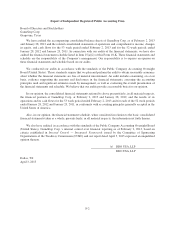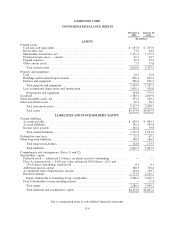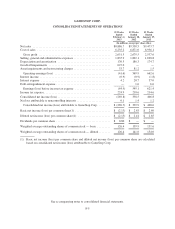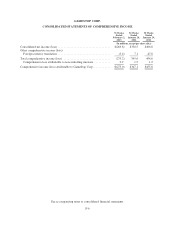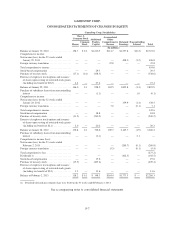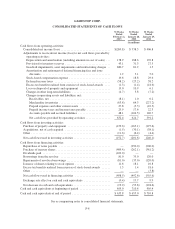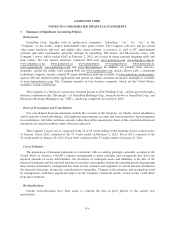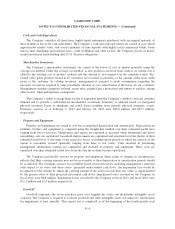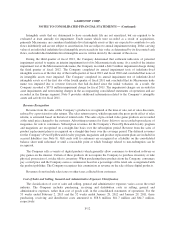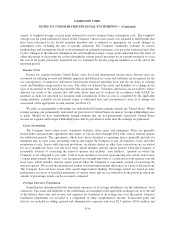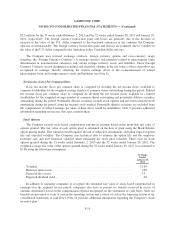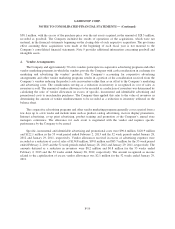GameStop 2012 Annual Report Download - page 87
Download and view the complete annual report
Please find page 87 of the 2012 GameStop annual report below. You can navigate through the pages in the report by either clicking on the pages listed below, or by using the keyword search tool below to find specific information within the annual report.GAMESTOP CORP.
NOTES TO CONSOLIDATED FINANCIAL STATEMENTS — (Continued)
Intangible assets that are determined to have an indefinite life are not amortized, but are required to be
evaluated at least annually for impairment. Trade names which were recorded as a result of acquisitions,
primarily Micromania, are considered indefinite-lived intangible assets as they are expected to contribute to cash
flows indefinitely and are not subject to amortization, but are subject to annual impairment testing. If the carrying
value of an individual indefinite-lived intangible asset exceeds its fair value as determined by its discounted cash
flows, such individual indefinite-lived intangible asset is written down by the amount of the excess.
During the third quarter of fiscal 2012, the Company determined that sufficient indicators of potential
impairment existed to require an interim impairment test of its Micromania trade name. As a result of the interim
impairment test of the Micromania trade name, the Company recorded a $44.9 million impairment charge during
the third quarter of fiscal 2012. The Company completed its annual impairment tests of indefinite-lived
intangible assets as of the first day of the fourth quarter of fiscal 2012 and fiscal 2010 and concluded that none of
its intangible assets were impaired. The Company completed its annual impairment test of indefinite-lived
intangible assets as of the first day of the fourth quarter of fiscal 2011 and concluded that its Micromania trade
name was impaired due to revenue forecasts that had declined since the initial valuation. As a result, the
Company recorded a $37.8 million impairment charge for fiscal 2011. The impairment charges are recorded in
asset impairments and restructuring charges in the accompanying consolidated statements of operations and are
recorded in the Europe segment. Note 9 provides additional information related to the Company’s intangible
assets and activity for fiscal 2011.
Revenue Recognition
Revenue from the sales of the Company’s products is recognized at the time of sale, net of sales discounts,
reduced by a provision for sales returns. The sales return reserve, which represents the gross profit effect of sales
returns, is estimated based on historical return levels. The sales of pre-owned video game products are recorded
at the retail price charged to the customer. Advertising revenues for Game Informer are recorded upon release of
magazines for sale to consumers. Subscription revenues for the Company’s PowerUp Rewards loyalty program
and magazines are recognized on a straight-line basis over the subscription period. Revenue from the sales of
product replacement plans is recognized on a straight-line basis over the coverage period. The deferred revenues
for the Company’s PowerUp Rewards loyalty program, magazines and product replacement plans are included in
accrued liabilities (see Note 8). Gift cards sold to customers are recognized as a liability on the consolidated
balance sheet until redeemed or until a reasonable point at which breakage related to non-redemption can be
recognized.
The Company sells a variety of digital products which generally allow consumers to download software or
play games on the internet. Certain of these products do not require the Company to purchase inventory or take
physical possession of, or take title to, inventory. When purchasing these products from the Company, consumers
pay a retail price and the Company earns a commission based on a percentage of the retail sale as negotiated with
the product publisher. The Company recognizes this commission as revenue on the sale of these digital products.
Revenues do not include sales taxes or other taxes collected from customers.
Cost of Sales and Selling, General and Administrative Expenses Classification
The classification of cost of sales and selling, general and administrative expenses varies across the retail
industry. The Company includes purchasing, receiving and distribution costs in selling, general and
administrative expenses, rather than cost of goods sold, in the consolidated statements of operations. For the
53 weeks ended February 2, 2013 and the 52 weeks ended January 28, 2012 and January 29, 2011, these
purchasing, receiving and distribution costs amounted to $58.8 million, $61.7 million and $64.7 million,
respectively.
F-12


